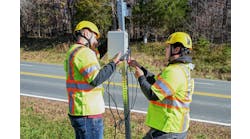By Daniel Venezuela, Contributing Author
Football games create traffic, and congestion causes a roadway safety risk.
This happens because football is a cultural phenomenon that connects communities at every level—from high school teams to the grandeur of the NFL’s ultimate showdown.
The excitement and anticipation of game day are shared by millions, but behind the scenes, a complex logistical challenge unfolds — managing the influx and outflow of thousands, sometimes hundreds of thousands, of vehicles and pedestrians.
As high school fans prepare for the playoffs and college and NFL fans focus on the home stretch of their team’s season, let’s explore how traffic control strategies are tailored to meet the unique demands of football games at each level, ensuring safety, efficiency and an enhanced experience for all attendees.
Tradition and Scale
Massillon, Ohio, is known as the "Birthplace of High School Football,” and its Ohio League team was one of the country’s first professional clubs. The Massillon Tigers boast a legacy dating back to the 1890s.
The high school program (also called the Massillon Tigers) has a storied history with 24 state championships and a roster of alumni who have played in the NFL. On game days, the town swells with fans, filling the 18,500-seat Paul Brown Tiger Stadium and the surrounding area.
Given the scale of these games, managing traffic effectively is crucial. The local traffic control team plays a vital role.
Their approach includes the strategic placement of safety equipment and signage around the stadium. They also manage shuttle buses that transport fans from overflow parking areas at nearby shopping centers, ensuring smooth transitions between different zones of fan activity.
The team's goal is to maintain a steady flow of vehicle and pedestrian traffic, minimizing delays and enhancing the overall game day experience.
The result is a well-orchestrated system that honors the tradition of Massillon football while adapting to modern-day challenges. Fans can arrive at and depart from the stadium efficiently, allowing the community to focus on the excitement of the game rather than the hassle of traffic.
Large Crowds and Complex Logistics
At the collegiate level, the stakes are even higher. A college football game can attract hundreds of thousands of people to parking lots. At some universities, many people go to the stadium just for the tailgating.
Texas A&M's Kyle Field, the largest stadium in the Southeastern Conference, regularly hosts crowds exceeding 102,000. Similarly, the University of Utah's Rice-Eccles Stadium and Utah State University's Maverik Stadium draw significant crowds, each presenting its own set of logistical challenges.
For Texas A&M, the traffic control strategy is comprehensive. With multiple access points, parking lots and garages, the team develops intricate traffic control plans that cater to the needs of vehicles and pedestrians.
“One of our goals is to ensure that emergency vehicles are able to quickly respond to calls even during peak traffic times,” said Scott Spencer, vice president of AWP Safety’s Central Division. “Keeping traffic organized and streets as clear as possible makes all the difference.”
Texas A&M has incorporated an innovative element into its traffic management: permanent rumble strips along George Bush Drive that play the rhythm of the school's fight song and add a unique touch to the game day experience.
In Utah, the traffic control teams for the Utes and Utah State Aggies face similar challenges. Their approach involves setting up and removing extensive equipment, including message boards and truck-mounted attenuators.
Road closures are carefully timed and executed to facilitate the rapid exit of fans after the game, reducing congestion.
“We set various lane closures about a week before and start closing major roads around the stadium the day of the game,” says Taylor Ferrin, area manager of AWP Safety’s operations in Ogden. “During and after the game we shut down a major six-lane road in front of the Utes’ stadium, which helps fans leave in about half the time it would take otherwise.”
These strategies help to ensure that despite the large crowds and complex logistics, traffic flows smoothly, and fans can enjoy a seamless game day experience. The ability to quickly clear major roads around the stadiums also contributes to the overall safety of the event, allowing fans to focus on the game rather than the journey.
The Ultimate Test of Traffic Control Expertise
On Sunday, Feb. 9, when the winner of the NFC meets the winner of the AFC for the NFL’s “Big Game,” a massive crowd will descend upon Caesars Superdome in New Orleans.
Managing traffic is a monumental task that requires tremendous coordination, precision and foresight. The big game not only attracts fans to the stadium but also generates a series of associated events that require careful planning and execution.
Road closures and traffic pattern changes will be designed and implemented to accommodate several days of events, including the main event, the game itself.
The traffic teams work closely with game day organizers and local law enforcement to create a management plan that balances the needs of motorists and pedestrians.
Thousands of pieces of equipment will be installed, ranging from traffic cones and barriers to message boards and lighting systems. These installations direct the flow of traffic and ensure that vehicles and people move safely and efficiently.
“We are in constant contact with game day organizers and local law enforcement to ensure everything goes according to plan,” said Spencer. “Every day should be fun and safe for football communities.”
Effective traffic control is crucial to the success of football events at every level. Be it a small-town stadium or the NFL’s brightest stage, the core principles of safety, efficiency and organization are essential.
Daniel Venezuela is general manager for AWP Safety’s Texas region.



